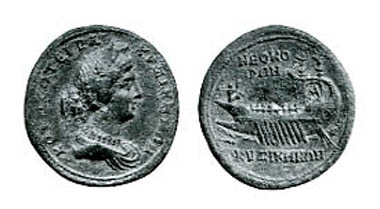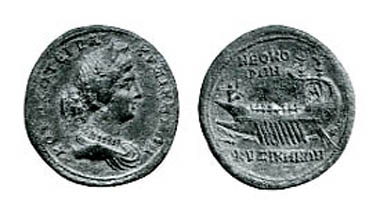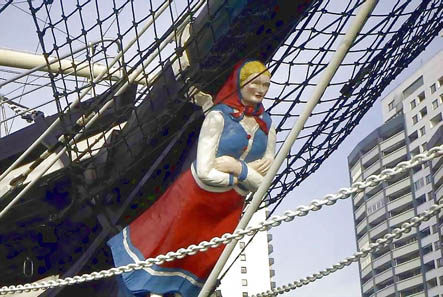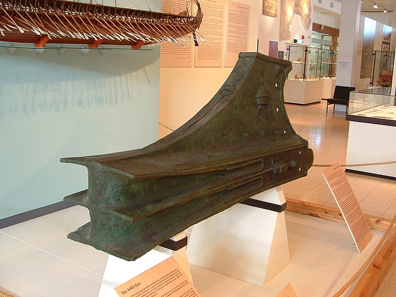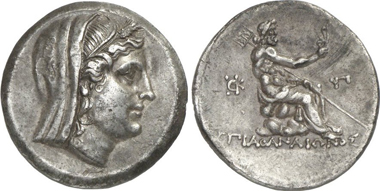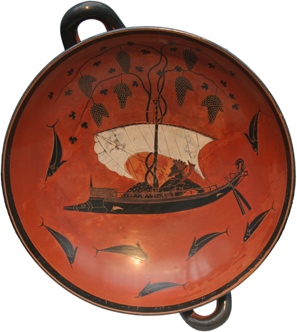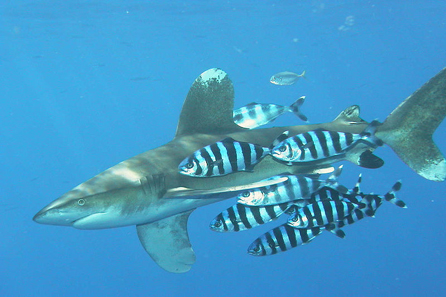Shipping and superstition in antiquity
In 175, Emperor Marcus Aurelius, accompanied by his wife Faustina, visited Kyzikos. This honor was a welcome opportunity for the city to issue a magnificent and comprehensive coin emission. One of the reverse dies shows in every detail the ship with which the emperor came to the city. This depiction shows many aspects that give us an idea about Roman shipbuilding.
Kyzikos (Mysia), bronze medallion, Faustina II. Rev.: war ship going l. On the prow Triton blowing the clam horn. Below the heavily curved stern, between two legionary eagles, a tent with keleustes (lat. symphoniacus or hortator) sitting inside who appears to hold a drumstick in the hand. Below the ship wavy lines and fish indicating the sea. Mion. II.542.193. From MMAG, Basel 81 (1995), 469.
Intruders in the boundless sea – that was how the Greeks regarded themselves, at the mercy of the power of the sea and the will of the gods that might send either a lucky passage or shipwreck and sinking. The only thing that helped was prayers, magic and good disguise. The ships were matched to the sea creatures, the hull became an animal, was animalized, as it were: the ram at the prow became an animal snout, an eye was painted onto the sidewall and the stern decoration, the aphlaston, was curved inwards, like a tail. Thus, the ‘ship animal’, thanks to magnificent mimicry, could plunge in the element of the sea without being considered alien and an intruder and consequently being destroyed.
Figurehead of Seute Deern. Photograph: Uwe Horst Friese, Bremerhaven / Wikipedia.
This wasn’t the only protection the ship was given by its creators. On this coin we can easily see the figurehead. It was thought to be a deity accompanying the ship that might protect it in case the gods of the country lost their power on the sea. It was situated at the ships’ front in order to be the first to spot the dangerous waves and, wherever possible, stop them. If a member of the ship’s crew had committed a sacrilege on board, the crew had to propitiate the deity in order to further enjoy its protection. When, for example, a sailor cut his hair or nails on board the entire ship was in danger of storm and sinking. Because the cut hair or finger nails symbolically represented the entire human being (just think of the Voodoo magic that gets magic only because of ingredients like these in the first place), the seafaring people believed that the sea would mobilize a storm to consume the whole man over which the sea had already some power thanks to the hair. That could only be prevented by appeasing the protecting deity at the prow with the blood of the evildoer. 40 lashes with the end of the rope averted the sinking of the ship.
Usually, the protecting deities were painted images of the gods that could be made without any great effort. Entire statues, like the one of the ship depicted here, were rare because they were expensive and nautically completely unpractical. We can infer from that that it had been a particularly luxurious state ship that brought the emperor to Kyzikos. Protecting deity was a statue of Triton. Being the son of Poseidon and Amphitrite, he had the lower body of a fish, clearly visible on the depiction. In his hand he holds a clam horn to blow.
This protecting deity wasn’t the only measure of precaution the ship builders resorted to in order to protect the ship from the waves. With its pointed form the prow decoration was apotropaic, i.e. warding off bad luck. Presumably it was gilded as well because anything shining brightly and sparkling was considered awful and terrible and hence averted evil.
Ram bow of a Greek ship, 2nd cent. B. C. Israeli National Maritime Museum – Exhibitions / Wikipedia.
The ram bow served to fight off enemies of another kind: for centuries, enemy ships were sunk by being impaled with a ram bow at the side. With clever rowing maneuvers the war ships in battle tried to get to the unprotected side of the enemy to attack it with the ram bow. This is why in the visual arts of antiquity the rowboat was regarded THE battle ship.
Because Greeks and Romans could only make use of the wind from behind as driving force, they prefer to rely on the safe driving force of the trained oarsmen. The mast was considered auxiliary rigging that could be swung in, if necessary, or left ashore in the first place. Only in the Byzantine fleet the stationary mast with the lateen sail was introduced, a triangular sail, invented by the Arabs, which enabled a ship to beat up.
On our coin we see 9 rudders originating from the outriggers. We can also see the first row of oarsmen. Actually, this first row might very well serve as pars pro toto, i.e. stand for at least three rowers per oar. In contrast to the Greeks who needed year-long training to navigate their battle ships, the Romans manned an oar with three men of which an experienced oarsman was the stroke whereas the others contributed with their heft only. The war ships were never manned with slaves. The oarsmen were soldiers; the hierarchy conformed to the one in the army. And there were the sea officers: the gubernator or helmsman, the proreus or bow lookout and the keleustes. The latter was paymaster and commissary, and he was responsible for the oarsmen. He gave the rhythm and the number of strokes. He was assisted by the smphoniacus, which we see inside the small tent at the prow where he gives the beat for the oarsmen. The most sacred place and the actual soul of the ship was the stern. This was why on Roman ships the standards were kept there. They are clearly discernible on both sides of the tent of the keleustes. The late Hellenistic-Roman ships knew the elevated stern with a gallery, a predecessor of the sterncastle, which provided space for luxurious cabins. Our coin, too, clearly shows the tent standing on an elevated platform under which most probably the cabins for the well-to-do travelers were situated.
In the rear part of the ship the oar is depicted. In antiquity it was considered sacred since it continuously plunged into the purifying power of the sea. The sea was considered cathartic. Thus, images of the gods were cleansed ceremonially in the sea. A man who lived his life in an exemplary manner was said to ‘live more sacred still than the helms’.
Byzantion (Thrace). Tetradrachm, 3rd cent. Demeter. Rev. Poseidon, holding an aphlaston in the elevated right hand. Schönert-Geiss 1002. From auction Gorny & Mosch 199 (2011), 142.
The rearmost part of the ship was the aphlaston, a decoration of the stern that was made of several finely split lumbers that were decorated with a round shield on Roman ships – unfortunately, this can’t be seen on this piece. The aphlaston consisted of the end of the bark lumbers that were arranged like a fan and bent inwards. It, too, was a ‘pars pro toto‘. Sea deities hold the aphlaston as attribute in the hand, and legendary Argo is said to have lost its aphlaston when passing through the clashing rocks, the Symplegades, when the rocks came together behind it. Hence, the rocks had taken the aphlaston of the Argo as sacrifice in place of the entire ship.
Seafaring people are superstitious. Being at the mercy of the elements continuously, they become receptive for premonition and oracles. Consequently, a developed art of forecast from the bodily convulsions of the crew members existed in Roman antiquity. We could only hope that, when the ship left for Kyzikos, the left side of the helmsman’s nose twitched for that meant a good trip and a safe arrival. On the other hand, the crew didn’t need to worry too much because the emperor as savior without doubt was eusebes (= pleasing God) and brought euploia (= good journey).
Thanks to personal piety, a pure person could serve as a lucky charm for the entire ship. In case that didn’t help (if, for example, the emperor had lost his purity because of his desire to conceive a child with his empress, a little brother for young Commodus – on a ship, that was considered sacrilegious), there would still be a woman on board, i.e. Faustina. According to the superstitious beliefs of the boatmen, she was able to calm the storm by baring her genital area; already the Lykian women had practiced that with success: with their garments raised they had made a flood sent by Poseidon float backwards.
Cup of Exekias. Dionysos sailing on a ship, surrounded by dolphins. Photograph: Matthias Kabel / Wikipedia.
Shipwrecking, however, was far from being imminent, as the coin clearly shows. Below the waves, in front of the ship two dolphins are depicted as companions. Dolphins were considered the most sacred and most divine of all sea animals, kings of all sea creatures, as it were. They were downright symbols for a good sea voyage, and Pliny 9.28 concedes that the legends about dolphins that had rescued ships or individual travelers from distress at sea were conspicuous. Dionysos had turned the crew of a pirate ship that had tried to kidnap him, into dolphins which, as atonement, had to accompany ships and make sure that they had a safe journey.
Sea chubs accompaning a whitetip reef shark. Photograph: Peter Kölbl / Wikipedia.
The coin from Kyzikus shows a second fish. Below the ship, close to the helm we see a Pompilos, a sea chub, a Naucrates ductor belonging to the family of Scombridae. As can be inferred from the depiction, his place was close to the helm at the stern from where he, according to superstition, navigated the ship until it reached the coastal area. There, he veered away and swam to the open seas to serve another ship as guide. Of course, these fish were subjects to a food taboo. After all, it would have been highly ungrateful of the seamen to eat their loyal guardians and companions.
With such faithful an escort the emperor couldn’t experience anything bad during his sea journey and so the ship’s prow says, in anticipation of what was to be exclaimed the moment the emperor set foot on solid and safe ground again: CHAIRE POLI, rejoice, city, for your emperor is coming.




